Up to 85% of plants depend on fungi to survive. Plants and fungi depend on each other for nutrient cycling and water absorption.
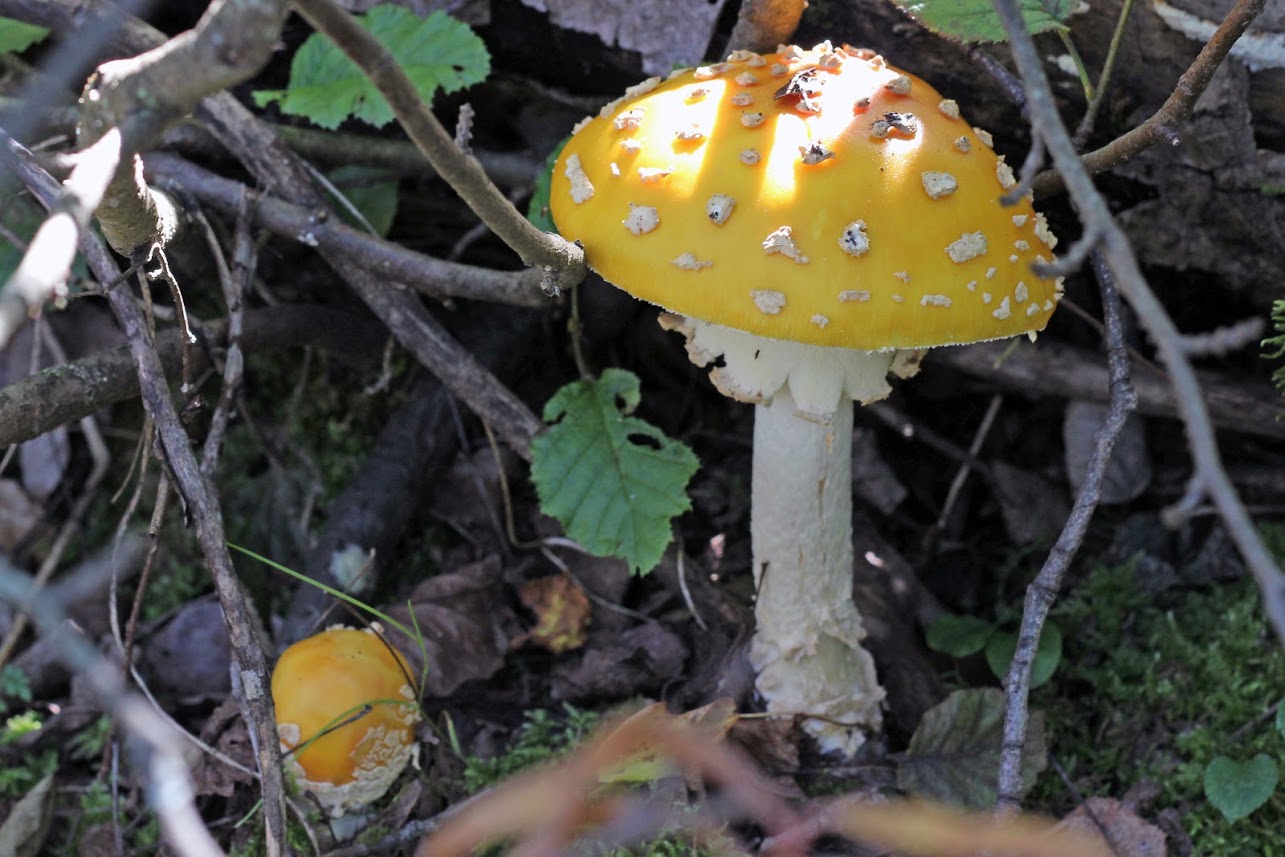
Photo: Amanita gemmata by Courtney Celley: US Fish & Wildlife Service
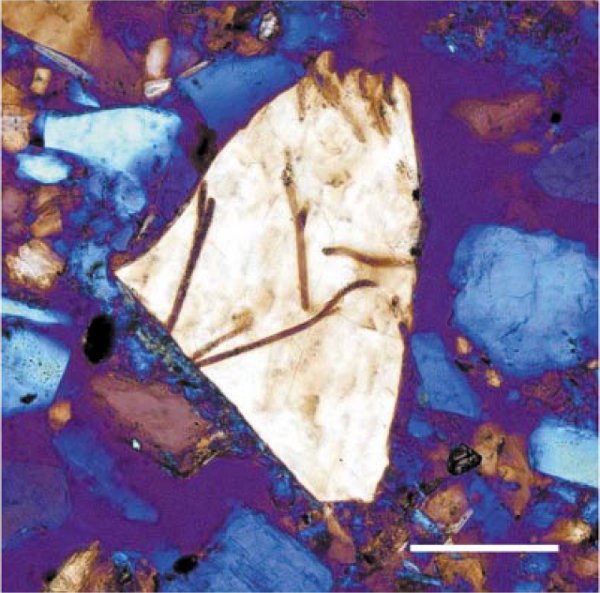 "If you sift the mineral particles from conifer forest soil, wash them, and examine them under a microscope, you will discover a startling detail: tiny tunnels, three to ten micrometers across" "If you sift the mineral particles from conifer forest soil, wash them, and examine them under a microscope, you will discover a startling detail: tiny tunnels, three to ten micrometers across"
"The tunnels curve and branch and sometimes more than one pierces the same particle. What could have created these microscopic boreholes?" - Jennifer Frazer
Image: Landeveert 2001 - Thin-section micrograph of a tunneled feldspar Scale bar = 100 micrometers
There was a nicely done article which came out on the journal Scientific American by science writer, Jennifer Frazer, who has degrees in biology, plant pathology and Mycology. I thought the beauty of post was that she has taken on the unseen microbial subject down onto a microscopic level to help the average reader understand what is going on in the complex sophisticated microscopic world where mycorrhizal fungi mine the soils not only for the basic food nutrients for plants we are familiar with like nitrogen, phosphorus, etc, but also those hard to come by trace elements [Zinc, Copper, Manganese, etc] which plants need for strong immune system health and survival against a potentially hostile world of pathogens. Oddly enough many soils are rich in important nutrients, but they are often locked up in a physical form which makes them unavailable to most plants. That's where the fungi come in. She references this photo here below to compare chemical weathering etches scar patterns [which she compares to an earthquake graph] into a mineral called Feldspar with the contrasting mycelial strands which have a twisting tangled pattern which fungi normally make.
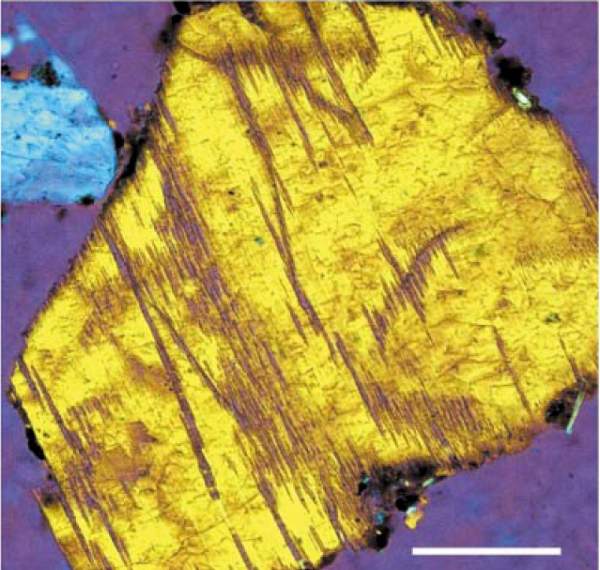
Although, interestingly, Fungi do manufacture a number of chemical acids and other enzymes which do indeed breakdown and weather rock in the soils. The photograph below she used for illustrative purposes only is Mold, growing in a Petri dish from a sample of dust and debris which was taken from some repair work in the bathroom of an apartment. To take this picture, the photographer, Bob Blaylock put the entire Petri dish on the stage of my microscope. The mold is growing in EasyGel nutrient from Wild Goose Science. The mold strands beautifully illustrate the same design patterns we see in the common mycorrhizal fungi hyphae which are clearly different from the chemical etching done on mineral rock if we were talking mere chemical reactions on stone.
"The tunnels seem like they were made by something … alive. They are the spitting image of hyphae – that is, filaments – of fungi."
Image: Landeveert 'Feldspar' 2001
 She then provided another beautiful illustration of something that the average person can actually see feel and touch. Something they may have commonly stumbled upon if they have ever gone for a walk in the woods. Most granite rocks and boulders in forests will be colonized by lichens and mosses. Most folks also understand the degradation and weathering effects that such organisms have on buildings like bricks, rock, rood slates or even the gravestones in a cemetery. She then provided another beautiful illustration of something that the average person can actually see feel and touch. Something they may have commonly stumbled upon if they have ever gone for a walk in the woods. Most granite rocks and boulders in forests will be colonized by lichens and mosses. Most folks also understand the degradation and weathering effects that such organisms have on buildings like bricks, rock, rood slates or even the gravestones in a cemetery.
"But why would a fungus tunnel into a rock? There’s no food there, and it no doubt takes a sizeable capital investment to assemble and secrete the acids necessary to eat raw rock."
"There is a precedent: lichens. The crusty creatures, a combination of fungi, algae, and attendant bacteria/archaea, are the first and last word in Earth-based rock colonization. Wherever naked stone is found, lichens will be there."
Image by Bob Blaylock (Mold - August 2010)
Sure enough. I've previous written articles on Biological soil crusts (Lichens, Mosses, Cyanobacteria, etc], from desert areas and also from here in Sweden within the shallow soils of some of this regions Boreal Forests. Such ecosystems are fascinating and foundations for any future life development. I wrote the Boreal Forest example specifically because most people find deserts boring and the soil crusts which exist there are probably not even remotely noticed by the average person. Hence the Boreal forest example has bigger and better examples of mosses, lichens and fungi which most people find more exciting and sexy when it comes to the visual. But it should be noted that Desert Biocrustal systems are equally important. I'll post the links below. But it is interesting that the microscopic deeper soil layers of this subject are not effected by the surface work from these living organisms.
 Photo: "Caloplaca thallincola" by Jymm - Licensed under Public Domain via Commons. Photo: "Caloplaca thallincola" by Jymm - Licensed under Public Domain via Commons.
"They cover almost 10% of Earth’s land surface, and if you are paying attention on your next forest or tundra hike, you will be astounded to note just how much real estate they have staked out – not just on rocks, but also on tree bark and soil."
"The fungal half of lichens are the drilling specialists, excreting acids that break down rock and enable the fungus to get a hypha-hold in micro-trenches, cracks, and etch pits (small lens-shaped cavities formed by the action of water). The acids are derived from the food that the algae provide to the fungus."
"But the shafts in the photos at the top of the page were found nowhere near a lichen or a boulder. They were inside little bits of stony soil. What other fungi could be driving these tunnels ?"
An interesting feature of the illustration below which you really don't see are those hormonal substances that the mycorrhizal fungi manufacture or produce which hinder or suppress the plant's root from growing root-hairs and might even encourage actual dichotomous branching from the root tip itself which will further enhance performance. So this tangled looking fungal mantle which covers this area of the root and inserts itself in between the cortical root cells is where all the interactions of nutrient, water and sugar exchanges take place between the fungi and the plant. This allows a much enhance performance of root area absorption than it had previously or if it were under and industrial science-based management as recommended by Dow Agro-Chemical and/or Monsanto. See how superior nature is compared to imaginary human improvements influenced by nothing more than bottom line profiteering ???

Reference: smith se read dj (1997) Mycorrhizal Symbiosis (second Adn) Academic Press
The illustrated image above also comes from her referenced resource material from the Department of Forest Mycology and Pathology, Swedish University of Agricultural Sciences here in Uppsala, Sweden. See how she describes what is going on in the above image:
"The fungus forms a root sheath called a “mantle”, and from this mantle, it sends hyphae both into the soil and into the root. The hyphae that invade the root do not actually invade the cells there. Instead, they weave a web around them, a structure known as the “Hartig Net”. Why would a tree put up with such a flagrant home invasion? To start, the net is a secure place where the fungus and the tree can exchange goodies.
"But fungi are also particularly good at seeking and absorbing (you might think of them as biological “Bounty”) owing to their diffuse bodies, which comprise a vast network of tiny tubes that max out surface area. Since fungi live in their food and secrete their digestive enzymes directly into it before resorbing the digested slurry, they are effectively one giant inside-out intestine (to those of you who dislike mushrooms, I apologize for putting you off them forever now -- though if it helps, mushrooms themselves generally do not digest anything, being strictly reproductive structures. That doesn't help either, does it?)."
She next provided the readers with an illustrative photo example of a soil penetrating root with end cap and it's fine root hairs without the colonization of the mycorrhizal fungi. The purpose really is to illustrate just how limited any plant is without the extra aftermarket add on parts I described in past posts where I previously compared a plant to a factory stock car out of the showroom and multiple species of fungi & bacteria comparison to all those after market performance enhancement auto parts, like a set of Hooker Headers which further enhance a stock automobile's high performance which makes it a true muscle car. Here is her description followed by the image:
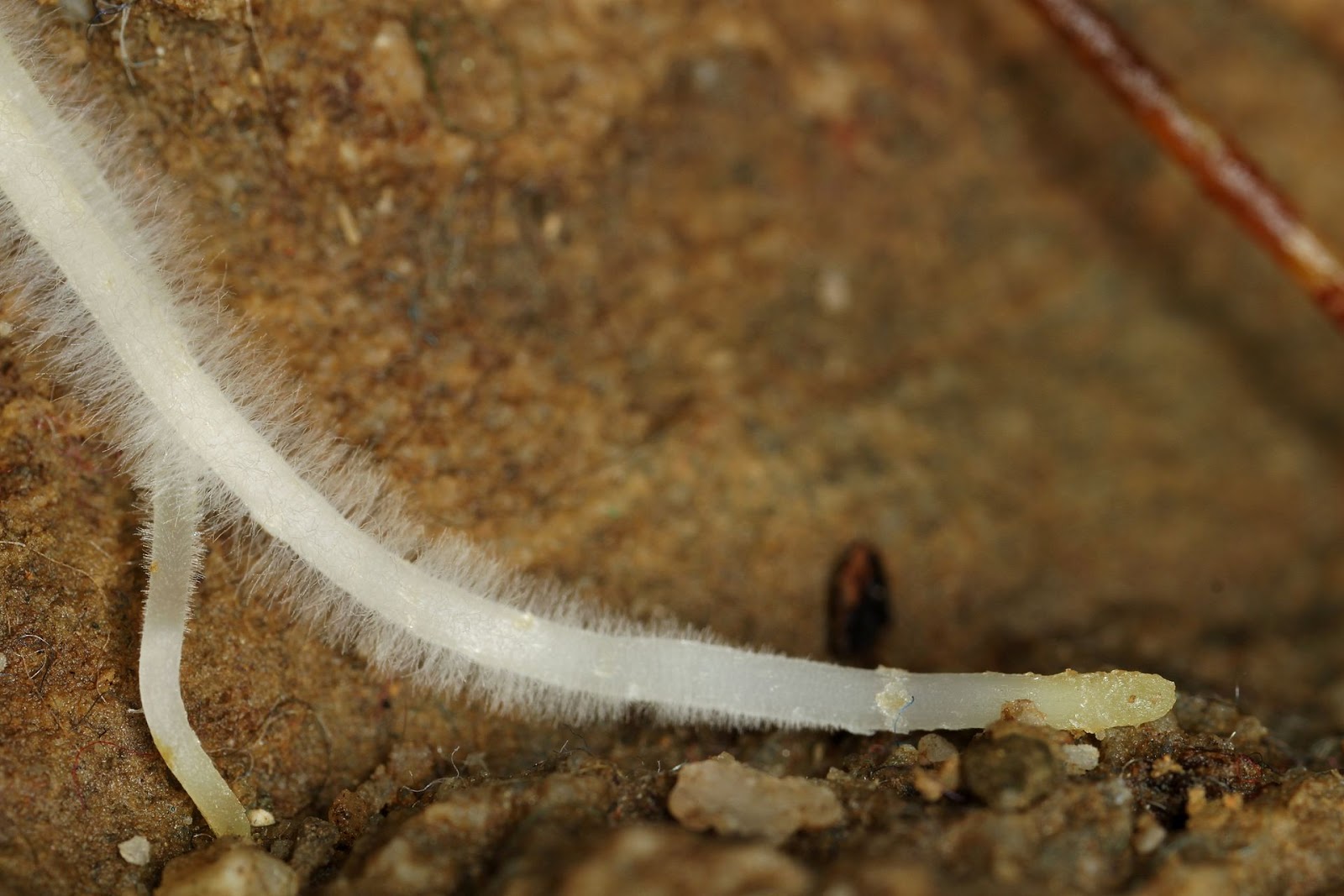 "Unassisted, trees are limited to their own relatively meager collection of root hairs, found only near the tips of roots. The rest of the root is just a conduit. Fungi, by contrast, absorb across their entire bodies. Furthermore, root tips are vastly larger than a hypha. Even root hair cells – the finest filament available to roots, which sprout from the side of root tips -- are around 15 micrometers in diameter. That’s one and a half to five times as large as a hypha. You can easily see them with the naked eye." "Unassisted, trees are limited to their own relatively meager collection of root hairs, found only near the tips of roots. The rest of the root is just a conduit. Fungi, by contrast, absorb across their entire bodies. Furthermore, root tips are vastly larger than a hypha. Even root hair cells – the finest filament available to roots, which sprout from the side of root tips -- are around 15 micrometers in diameter. That’s one and a half to five times as large as a hypha. You can easily see them with the naked eye."
Image: Oergon Caves, by AnimalParty - Wiki Commons (2011)
Now what I find interesting about this image above is that it also beautifully illustrates the limited nutrient and water uptake infrastructure of a farm crop grown which is common with the maintenance recommendations of the conventional industrial business model we have today. If we just focus strictly on how the synthetic fertilizer inputs and all other synthetic pesticides actually cause a sterile soil system, the dosage concentration must be high enough so that a certain percentage will be actually used by the crop plant. It's a numbers game. The plant has certain specific requirements for proper growth. The industrial practices deliberately limit how much rooting absorption area will actually exist in the soils. So the chemical potency needs to be high enough to ensure that enough uptake from the limited root infrastructure will provide such requirements to the plant's above ground food producing factory. Such high potency of chemical inputs also assure that the mycorrhizal fungi will never colonize these crop plant root systems. The high synthetic fertilizer potency triggers an epigenetic switch within the plant's DNA to actually turn off production of the chemical signaling which sends a message to fungal spores or hyphal strands to colonize the root. If the mycorrhizal fungi already exist, the shut off switch will trigger the fungi to detach from the root system. In any event, the root absorption area becomes far limited and the soil changes from a mycorrhizal soil to a bacterial one which actually favours weed (ruderals) competition.
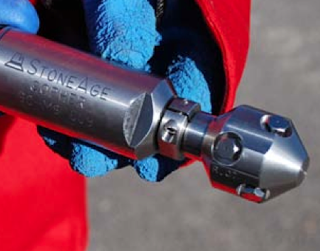 This is because a mycorrhizal system will outcompete the weeds for available phosphorus. If there are any weeds that do germinate, they will be greatly stunted in growth. This also benefits the Agro-Chemical companies who want to sell the farmers more synthetics to kill off those weeds. The conventional Agro-system remains flawed, inferior, but this at the same time allows the industrial business model to remain intact and more powerful. It's extremely important for everyone to understand where the problem lies, what makes it flawed and why there are such powerful lobbies to keep the status quo. But there is more in understanding how this root structure operates by illustrating things we see and use in our world. Look at the illustration below. This is a core boring and cleaning device with water jets engineered into the head for cleaning out a bore hole.
Image; Stone Age Gopher Water Injection Bore Hole Head
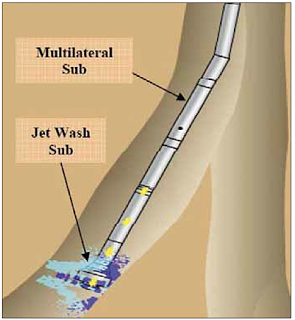 Like an industrial water well drilling bit designed with jets to soften, lubricate and cool down the material ahead of it so that the drill head can more easily bore a round core through rock and other challenging material, a plant's root system also can itself bore through many challenging materials. The illustration at right shows that such technologies may also be used in branching off a main bore hole shaft and going horizontally, just as plant roots do. As I have written about previously, there are several shrubs and trees which have an incredible ability known as hydraulic lift & Redistribution of water from deeper layers to the surfaces which also may be shared with other shallower rooted plants. But the reverse is also possible and it's known as hydraulic descent where water is taken from the surface during rain storms and stored into the deeper layers of the sub-soils. The plants have a tough root cap which can expand it's growth further into tough soil materials with the help of water and other enzymes it itself may produce. But the plant is limited and this is where the fungi also manufacture enzymes and biologically created acids to dissolve minerals pushing ever further into newer soil regions that the plant wouldn't otherwise have access to and on a microscopic level. Like an industrial water well drilling bit designed with jets to soften, lubricate and cool down the material ahead of it so that the drill head can more easily bore a round core through rock and other challenging material, a plant's root system also can itself bore through many challenging materials. The illustration at right shows that such technologies may also be used in branching off a main bore hole shaft and going horizontally, just as plant roots do. As I have written about previously, there are several shrubs and trees which have an incredible ability known as hydraulic lift & Redistribution of water from deeper layers to the surfaces which also may be shared with other shallower rooted plants. But the reverse is also possible and it's known as hydraulic descent where water is taken from the surface during rain storms and stored into the deeper layers of the sub-soils. The plants have a tough root cap which can expand it's growth further into tough soil materials with the help of water and other enzymes it itself may produce. But the plant is limited and this is where the fungi also manufacture enzymes and biologically created acids to dissolve minerals pushing ever further into newer soil regions that the plant wouldn't otherwise have access to and on a microscopic level.
"Taken together, these traits mean fungi can probe and penetrate crevices that roots and root hairs cannot. Thus by partnering with fungi, trees can make use of a much larger soil volume than roots alone could do, and can consequently absorb more water and nutrients than trees without fungal partners."
"Ectomycorrhizal fungi hold up their end of the deal by secreting acids that dissolve mineral particles from a distance. Via special digestive proteins called enzymes, they can also access organic forms of nitrogen and phosphorous in the soil (like amino acids, peptides, proteins, amino sugars, chitin, and nucleic acids) that plants wouldn’t otherwise be able to exploit. But there is a lot of other competition in the soil for these nutrients -- from other fungi, from bacteria, and from protists."
"And the tunnels in those mineral particles sure looked suspicious."
"Scientsts began to connect the dots. What if ectomycorrhizal fungi were not just passively sopping up whatever nitrogen, phosphorous, magnesium, potassium, calcium and iron they could scavenge from the soil? What if ... what if ectomycorrhizal fungi are actually mining hard rock for their trees?"
"One clue can be found by looking at thin sections of fungus-enveloped root still embedded in soil. In this sample, probing hyphae sprouted from the mantle have wrapped mineral particles in a fungal embrace."
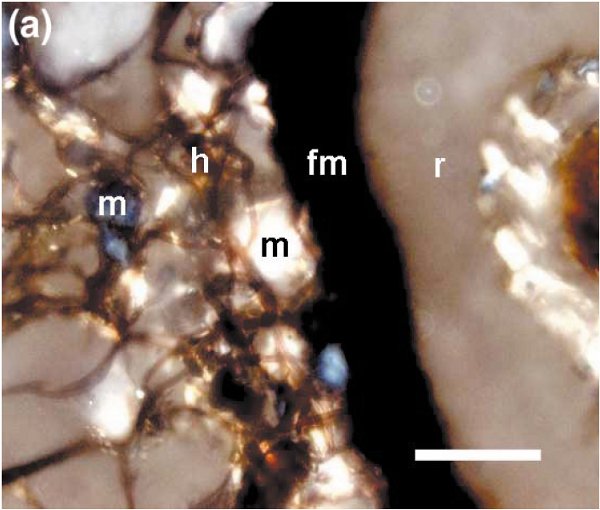 Image: Landweert et al 2001 Image: Landweert et al 2001
In the photograph to the right, notice the thin section of an ectomycorrhizal root tip showing root (r), fungal mantle (fm), mineral particles (m), and ectomycorrhizal hyphae (h). Scale bar = 50 micrometers. Scanning electron micrographs of these particles show the fungi not only grasping, but invading them. In the photograph below again notice the scanning electron micrograph of branching hyphae that embraced and penetrated a mineral particle. Fungi seem to enter the particle at upper right and center right. Scale bar = 10 micrometers.
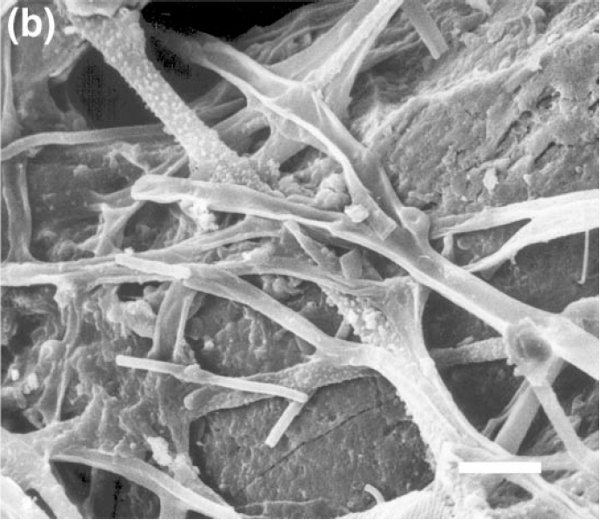 "As you saw in the image at the top of this post, thin cross sections taken from tiny pieces of feldspar and hornblende – common minerals in conifer forest soil – reveal tunnels inside with rounded ends, curving paths, and constant 3-10 micrometer diameters that also seem to finger fungi as their drivers." "As you saw in the image at the top of this post, thin cross sections taken from tiny pieces of feldspar and hornblende – common minerals in conifer forest soil – reveal tunnels inside with rounded ends, curving paths, and constant 3-10 micrometer diameters that also seem to finger fungi as their drivers."
"Scientists speculate that secretions of organic acids at the tip of the hyphae driving the tunnels release potassium, calcium, and magnesium ions from the mineral, simultaneously excavating the tunnel and releasing these valuable elements for absorption."
"Could anything else be responsible?"
"Scientists have also observed that the tunnels are found most commonly near the soil surface, and much more rarely deeper down. That definitely seems to implicate something alive."
"And as mentioned above, the tunnels look radically different from the etch pits and saw-tooth cracks that are the hallmarks of purely chemical weathering. As a result, scientists now think ectomycorrhizal fungi have *two* ways of shanghai-ing nutrients for their trees, summarized below."
Illustration: Landweert 2001
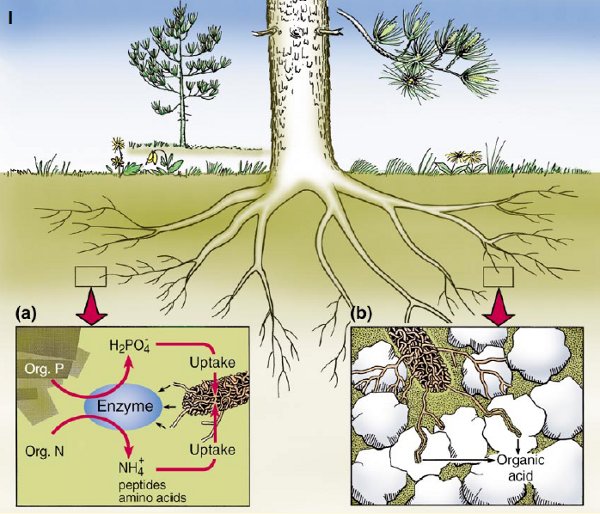
"Fungi can access organic sources of phosphorous and nitrogen that would otherwise be unavailable to trees via enzymes they make, but also by mining soil minerals"
"Fungal mining has many advantages. Some feldspars contain pockets of apatite, a major source of phosphorous in forests. By excavating these otherwise locked nutrient chambers, fungi are able to access a phosphorous source that would be unavailable to plant roots alone."
"Fungal tunnels and the acids used to make them also speed up mineral decay and increase mineral surface area available directly to plant roots. Futher, fungal mining cuts off competition from other soil microbes for nutrients by accessing minerals in seclusion directly at the source. And it provides trees access to minerals even in acidified soil (the product of decades of acid rain), which can make grabbing them straight from the soil more difficult chemically."
"The speed with which fungi drive their tunnels is not blinding, but not glacial either, considering the miner is just a few micrometers across. One estimate suggests that the tips of fungal hyphae could be pushing their leads at the rate of 0.3-30 micrometers per year. If so, the authors calculated that 150 meters of pores are formed each year per liter of “E horizon” soil – a type of forest dirt leached of many minerals. In this same relatively small volume, 10,000,000 hyphal tips would be tunneling into sand grains at any given moment."
"Spread across the soil of an entire planet, the extent of fungal mining surely dwarfs anything undertaken by humans. Its scale, and the volume of soil that fungi have helped create over what may be half a billion years of delving, beggar belief."
Source: Scientific American & Jennifer Frazer (http://creating-a-new-earth.blogspot.ca/2015/11/mycorrhizal-fungi-run-largest-mining.html)
|